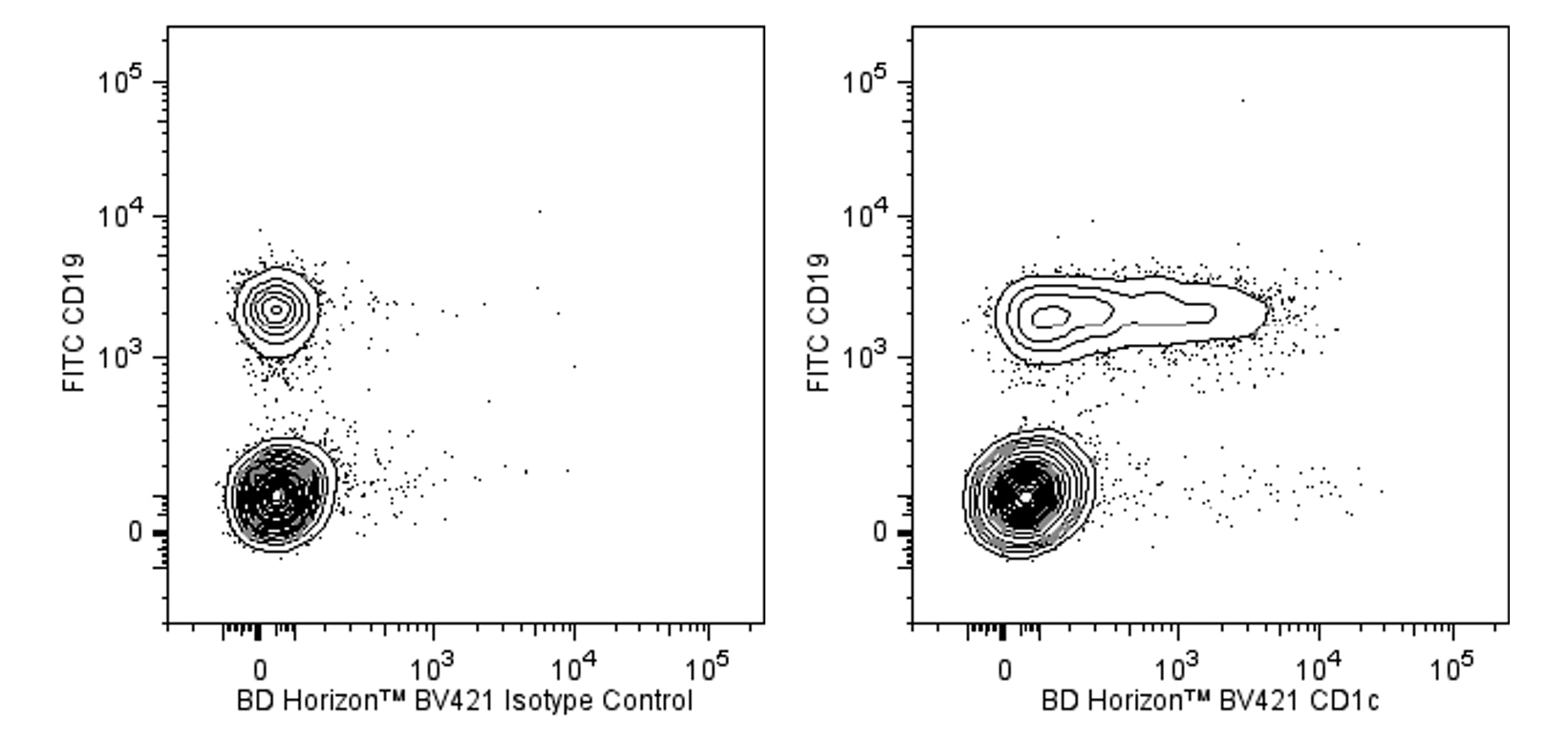Old Browser
This page has been recently translated and is available in French now.
Looks like you're visiting us from {countryName}.
Would you like to stay on the current country site or be switched to your country?




Two-color flow cytometric analysis of CD1c expression on human peripheral blood lymphocytes. Human whole blood was stained with FITC Mouse Anti-Human CD19 antibody (Cat. No. 555412/560994) and either BD Horizon™ BV421 Mouse IgG1, κ Isotype Control (Cat. No. 562438; Left Panel) or BD Horizon™ BV421 Mouse Anti-Human CD1c (Cat. No. 565050/565051; Right Panel). Erythrocytes were lysed with BD FACS Lysing Solution (Cat. No. 349202). Two-color flow cytometric contour plots showing the correlated expression of CD1c (or Ig Isotype control staining) versus CD19 were derived from gated events with the forward and side light-scatter characteristics of intact lymphocytes. Flow cytometric analysis was performed using a BD™ LSR II Flow Cytometer System.


BD Horizon™ BV421 Mouse Anti-Human CD1c

Regulatory Status Legend
Any use of products other than the permitted use without the express written authorization of Becton, Dickinson and Company is strictly prohibited.
Preparation And Storage
Product Notices
- This reagent has been pre-diluted for use at the recommended Volume per Test. We typically use 1 × 10^6 cells in a 100-µl experimental sample (a test).
- An isotype control should be used at the same concentration as the antibody of interest.
- Caution: Sodium azide yields highly toxic hydrazoic acid under acidic conditions. Dilute azide compounds in running water before discarding to avoid accumulation of potentially explosive deposits in plumbing.
- Source of all serum proteins is from USDA inspected abattoirs located in the United States.
- Pacific Blue™ is a trademark of Molecular Probes, Inc., Eugene, OR.
- For fluorochrome spectra and suitable instrument settings, please refer to our Multicolor Flow Cytometry web page at www.bdbiosciences.com/colors.
- Please refer to www.bdbiosciences.com/us/s/resources for technical protocols.
Companion Products






The F10/21A3 monoclonal antibody specifically binds to CD1c. The CD1 family of transmembrane glycoproteins are structurally related to the classical major histocompatibility complex (MHC) proteins. CD1c is a type I transmembrane glycoprotein that forms heterodimers with beta-2-microglobulin. CD1c presents lipids and glycolipids of self or microbial origin to T cells. CD1c is expressed by Langerhans cells, dendritic cells, monocytes, cortical thymocytes, T cells, and some B cells.
The antibody was conjugated to BD Horizon BV421 which is part of the BD Horizon Brilliant™ Violet family of dyes. With an Ex Max of 407-nm and Em Max at 421-nm, BD Horizon BV421 can be excited by the violet laser and detected in the standard Pacific Blue™ filter set (eg, 450/50-nm filter). BD Horizon BV421 conjugates are very bright, often exhibiting a 10 fold improvement in brightness compared to Pacific Blue conjugates.

Development References (3)
-
Delia D, Cattoretti G, Polli N, et al. CD1c but neither CD1a nor CD1b molecules are expressed on normal, activated, and malignant human B cells: identification of a new B-cell subset. Blood. 1988; 72(1):241-247. (Biology). View Reference
-
Grant EP, Degano M, Rosat JP, et al. Molecular recognition of lipid antigens by T cell receptors. J Exp Med. 1999; 189(1):195-205. (Clone-specific: Blocking, Functional assay, Inhibition). View Reference
-
Moody DB, Ulrichs T, Mühlecker W, et al. CD1c-mediated T-cell recognition of isoprenoid glycolipids in Mycobacterium tuberculosis infection. Nature. 2000; 404(6780):884-888. (Clone-specific: Blocking, Functional assay, Inhibition). View Reference
Please refer to Support Documents for Quality Certificates
Global - Refer to manufacturer's instructions for use and related User Manuals and Technical data sheets before using this products as described
Comparisons, where applicable, are made against older BD Technology, manual methods or are general performance claims. Comparisons are not made against non-BD technologies, unless otherwise noted.
For Research Use Only. Not for use in diagnostic or therapeutic procedures.
Report a Site Issue
This form is intended to help us improve our website experience. For other support, please visit our Contact Us page.